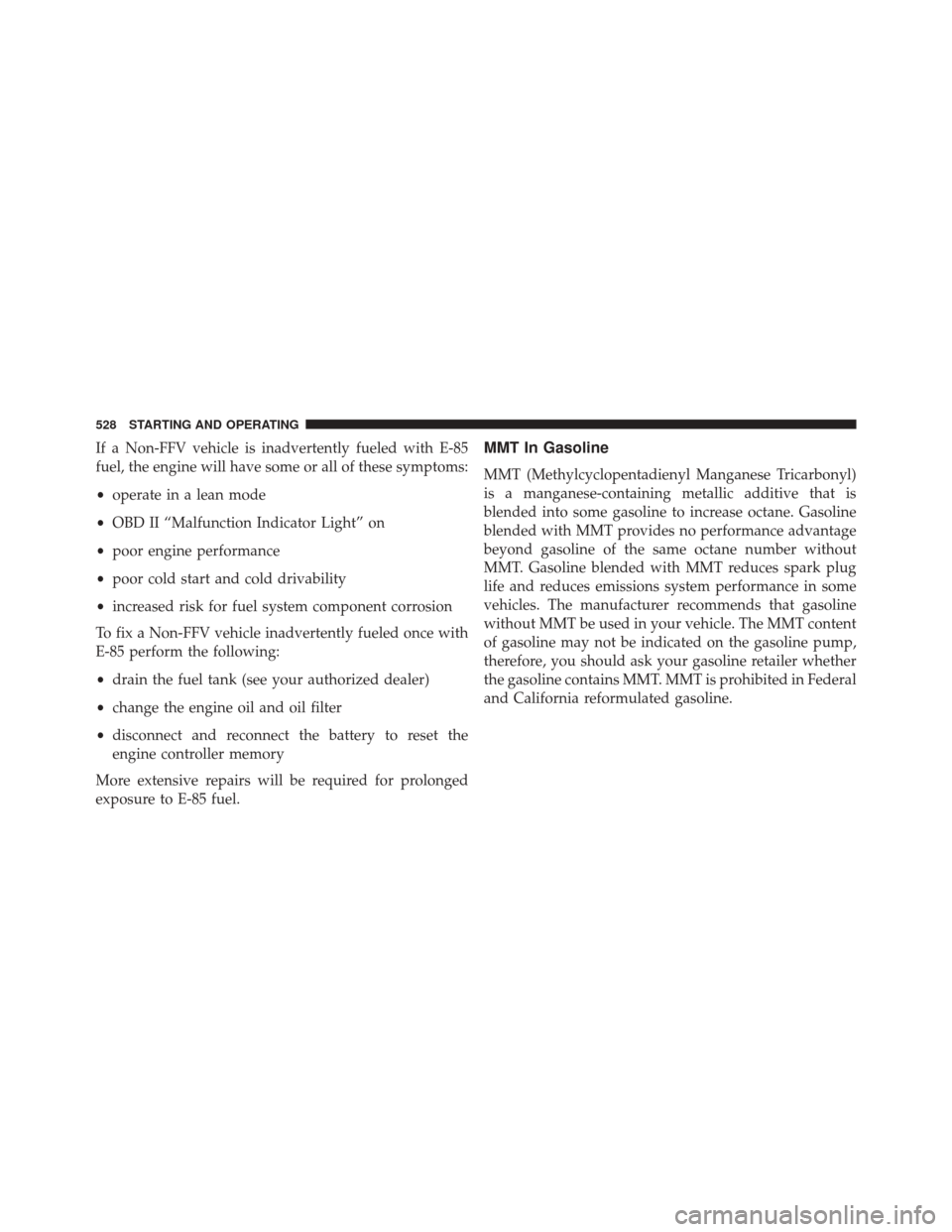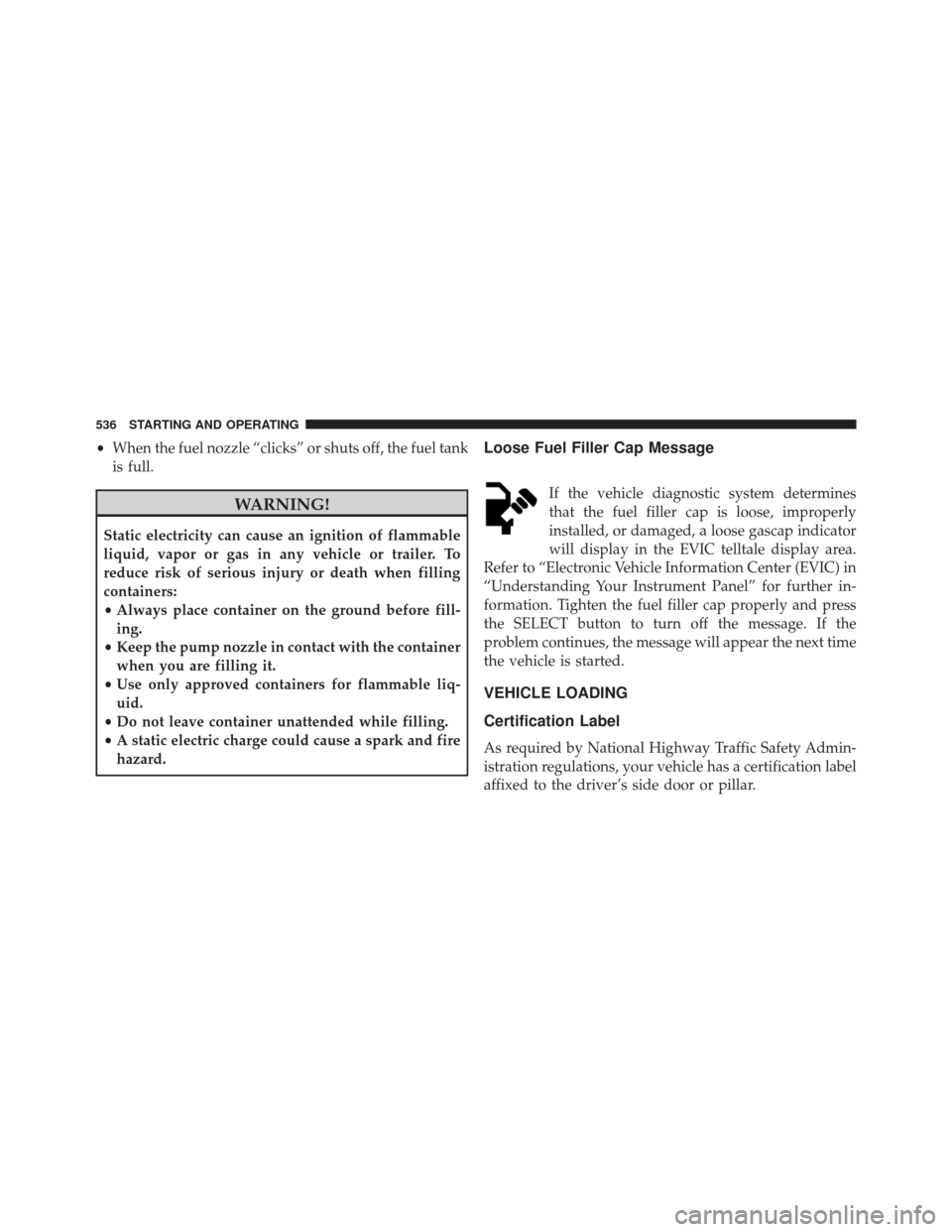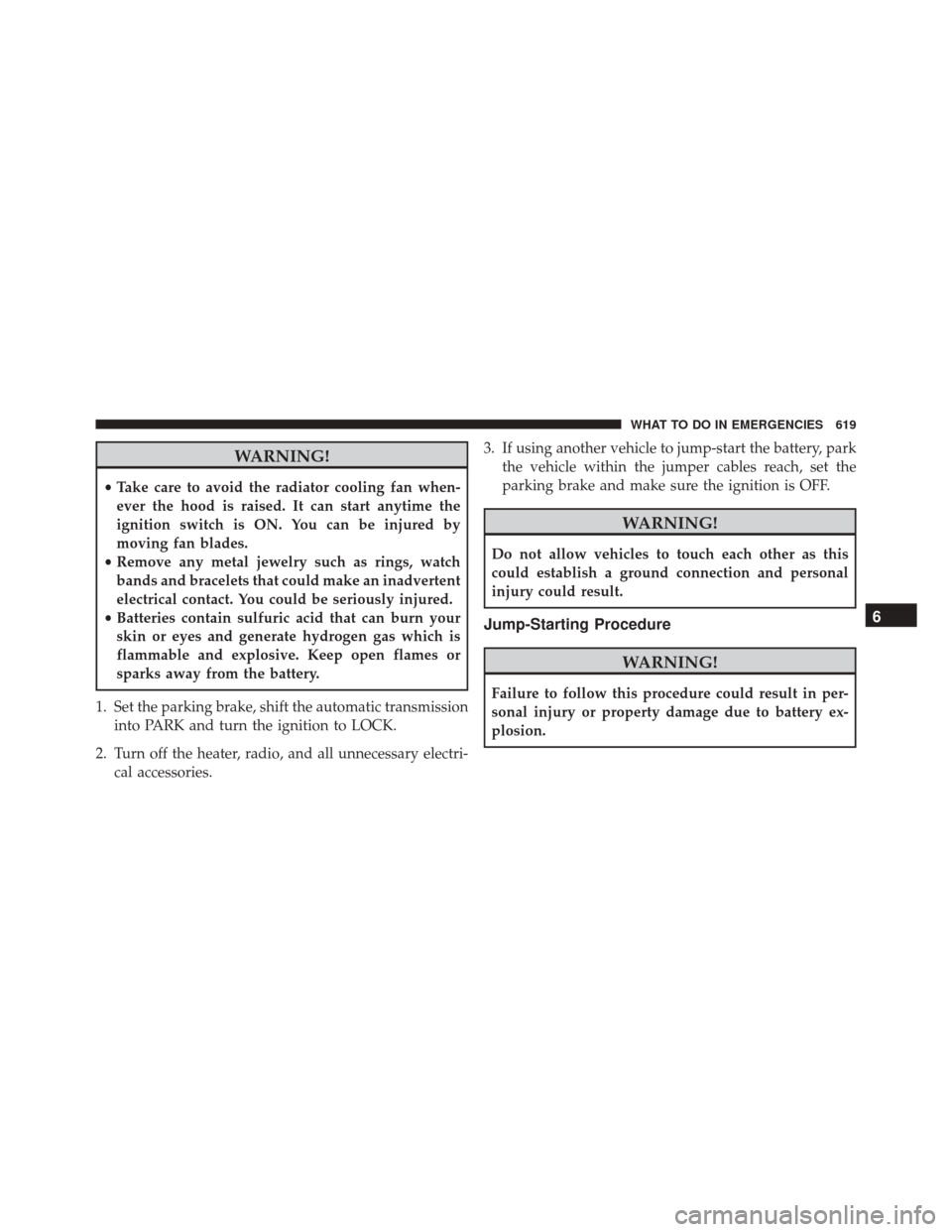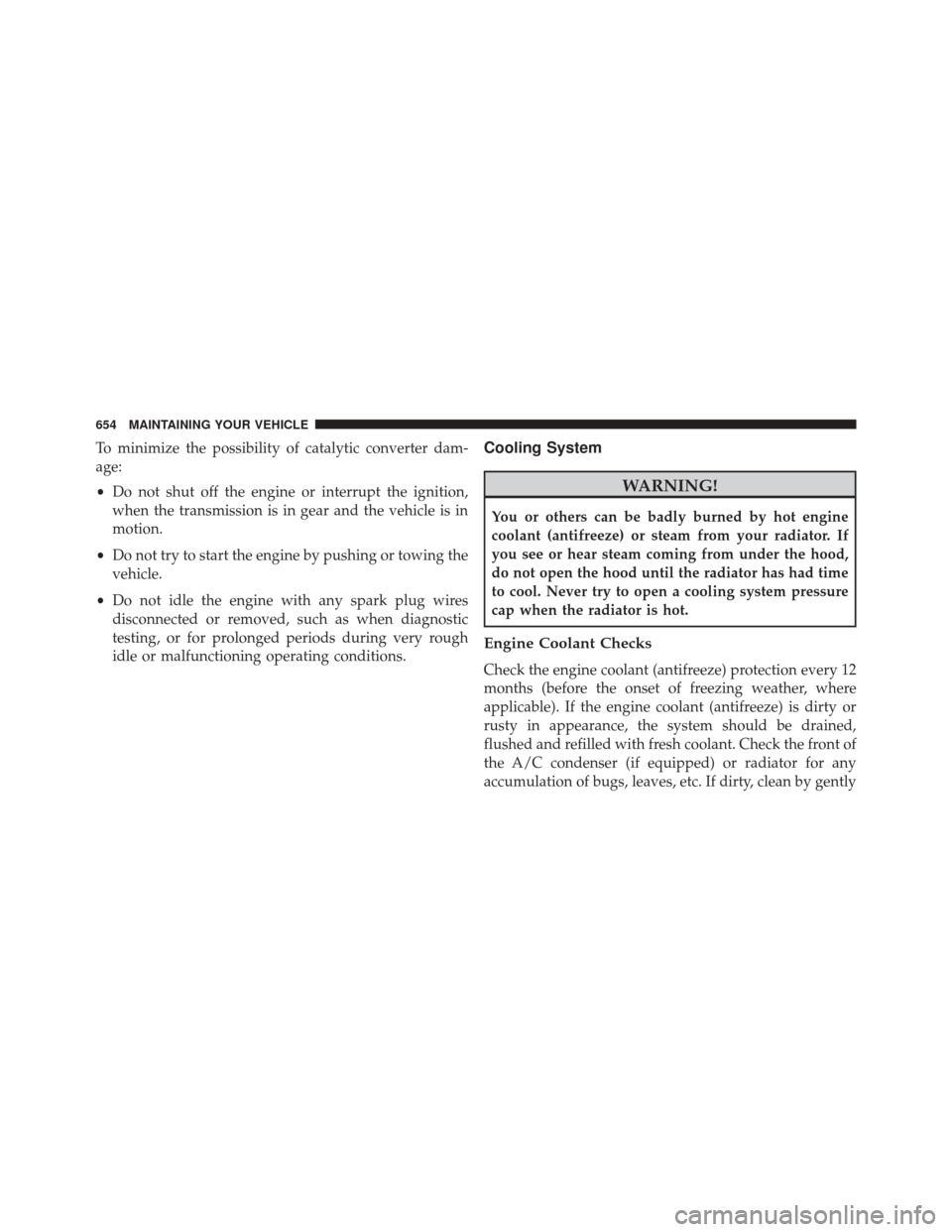spark Ram 2500 2013 Owner's Manual
[x] Cancel search | Manufacturer: RAM, Model Year: 2013, Model line: 2500, Model: Ram 2500 2013Pages: 743, PDF Size: 5.43 MB
Page 528 of 743

FUEL REQUIREMENTS
3.6L And 4.7L Engine
These engines are designed to meet all
emissions regulations and provide excel-
lent fuel economy and performance when
using high quality unleaded “regular”
gasoline having an octane rating of 87. The
use of premium gasoline is not recommended, as it will
not provide any benefit over regular gasoline in these
engines.
5.7L Engine
This engine is designed to meet all emis-
sions regulations and provide satisfactory
fuel economy and performance when us-
ing high quality unleaded gasoline having an octane range of 87 to 89. The manufacturer recom-
mends the use of 89 octane for optimum performance.
The use of premium gasoline is not recommended, as it
will not provide any benefit over regular gasoline in
these engines.
Light spark knock at low engine speeds is not harmful to
your engine. However, continued heavy spark knock at
high speeds can cause damage and immediate service is
required. Poor quality gasoline can cause problems such
as hard starting, stalling, and hesitations. If you experi-
ence these symptoms, try another brand of gasoline
before considering service for the vehicle.
Over 40 auto manufacturer’s world wide have issued and
endorsed consistent gasoline specifications (the World-
wide Fuel Charter, WWFC) which define fuel properties
necessary to deliver enhanced emissions, performance,
and durability for your vehicle. The manufacturer recom-
mends the use of gasolines that meet the WWFC speci-
fications, if they are available.
526 STARTING AND OPERATING
Page 530 of 743

If a Non-FFV vehicle is inadvertently fueled with E-85
fuel, the engine will have some or all of these symptoms:
•operate in a lean mode
• OBD II “Malfunction Indicator Light” on
• poor engine performance
• poor cold start and cold drivability
• increased risk for fuel system component corrosion
To fix a Non-FFV vehicle inadvertently fueled once with
E-85 perform the following:
• drain the fuel tank (see your authorized dealer)
• change the engine oil and oil filter
• disconnect and reconnect the battery to reset the
engine controller memory
More extensive repairs will be required for prolonged
exposure to E-85 fuel.MMT In Gasoline
MMT (Methylcyclopentadienyl Manganese Tricarbonyl)
is a manganese-containing metallic additive that is
blended into some gasoline to increase octane. Gasoline
blended with MMT provides no performance advantage
beyond gasoline of the same octane number without
MMT. Gasoline blended with MMT reduces spark plug
life and reduces emissions system performance in some
vehicles. The manufacturer recommends that gasoline
without MMT be used in your vehicle. The MMT content
of gasoline may not be indicated on the gasoline pump,
therefore, you should ask your gasoline retailer whether
the gasoline contains MMT. MMT is prohibited in Federal
and California reformulated gasoline.
528 STARTING AND OPERATING
Page 538 of 743

•When the fuel nozzle “clicks” or shuts off, the fuel tank
is full.
WARNING!
Static electricity can cause an ignition of flammable
liquid, vapor or gas in any vehicle or trailer. To
reduce risk of serious injury or death when filling
containers:
• Always place container on the ground before fill-
ing.
• Keep the pump nozzle in contact with the container
when you are filling it.
• Use only approved containers for flammable liq-
uid.
• Do not leave container unattended while filling.
• A static electric charge could cause a spark and fire
hazard.
Loose Fuel Filler Cap Message
If the vehicle diagnostic system determines
that the fuel filler cap is loose, improperly
installed, or damaged, a loose gascap indicator
will display in the EVIC telltale display area.
Refer to “Electronic Vehicle Information Center (EVIC) in
“Understanding Your Instrument Panel” for further in-
formation. Tighten the fuel filler cap properly and press
the SELECT button to turn off the message. If the
problem continues, the message will appear the next time
the vehicle is started.
VEHICLE LOADING
Certification Label
As required by National Highway Traffic Safety Admin-
istration regulations, your vehicle has a certification label
affixed to the driver’s side door or pillar.
536 STARTING AND OPERATING
Page 621 of 743

WARNING!
•Take care to avoid the radiator cooling fan when-
ever the hood is raised. It can start anytime the
ignition switch is ON. You can be injured by
moving fan blades.
• Remove any metal jewelry such as rings, watch
bands and bracelets that could make an inadvertent
electrical contact. You could be seriously injured.
• Batteries contain sulfuric acid that can burn your
skin or eyes and generate hydrogen gas which is
flammable and explosive. Keep open flames or
sparks away from the battery.
1. Set the parking brake, shift the automatic transmission into PARK and turn the ignition to LOCK.
2. Turn off the heater, radio, and all unnecessary electri- cal accessories. 3. If using another vehicle to jump-start the battery, park
the vehicle within the jumper cables reach, set the
parking brake and make sure the ignition is OFF.
WARNING!
Do not allow vehicles to touch each other as this
could establish a ground connection and personal
injury could result.
Jump-Starting Procedure
WARNING!
Failure to follow this procedure could result in per-
sonal injury or property damage due to battery ex-
plosion.
6
WHAT TO DO IN EMERGENCIES 619
Page 622 of 743

CAUTION!
Failure to follow these procedures could result in
damage to the charging system of the booster vehicle
or the discharged vehicle.
1. Connect the positive (+)end of the jumper cable to the
positive (+)post of the discharged vehicle.
2. Connect the opposite end of the positive (+)jumper
cable to the positive (+)post of the booster battery.
3. Connect the negative end (-)of the jumper cable to the
negative (-)post of the booster battery.
4. Connect the opposite end of the negative (-)jumper
cable to a good engine ground (exposed metal part of
the discharged vehicle’s engine) away from the battery
and the fuel injection system.
WARNING!
Do not connect the cable to the negative post (-) of the
discharged battery. The resulting electrical spark
could cause the battery to explode and could result in
personal injury.
5. Start the engine in the vehicle that has the booster battery, let the engine idle a few minutes, and then
start the engine in the vehicle with the discharged
battery.
Once the engine is started, remove the jumper cables in
the reverse sequence:
6. Disconnect the negative (-)jumper cable from the
engine ground of the vehicle with the discharged
battery.
7. Disconnect the negative end (-)of the jumper cable
from the negative (-)post of the booster battery.
620 WHAT TO DO IN EMERGENCIES
Page 649 of 743

Maintenance-Free Battery
Your vehicle is equipped with a maintenance-free battery.
You will never have to add water, nor is periodic main-
tenance required.
WARNING!
•Battery fluid is a corrosive acid solution and can
burn or even blind you. Do not allow battery fluid
to contact your eyes, skin, or clothing. Do not lean
over a battery when attaching clamps. If acid
splashes in eyes or on skin, flush the area imme-
diately with large amounts of water. Refer to
“Jump-Starting Procedures” in “What To Do In
Emergencies” for further information.
(Continued)
WARNING! (Continued)
•Battery gas is flammable and explosive. Keep
flame or sparks away from the battery. Do not use
a booster battery or any other booster source with
an output greater than 12 Volts. Do not allow cable
clamps to touch each other.
• Battery posts, terminals, and related accessories
contain lead and lead compounds. Wash hands
after handling.
7
MAINTAINING YOUR VEHICLE 647
Page 656 of 743

To minimize the possibility of catalytic converter dam-
age:
•Do not shut off the engine or interrupt the ignition,
when the transmission is in gear and the vehicle is in
motion.
• Do not try to start the engine by pushing or towing the
vehicle.
• Do not idle the engine with any spark plug wires
disconnected or removed, such as when diagnostic
testing, or for prolonged periods during very rough
idle or malfunctioning operating conditions.Cooling System
WARNING!
You or others can be badly burned by hot engine
coolant (antifreeze) or steam from your radiator. If
you see or hear steam coming from under the hood,
do not open the hood until the radiator has had time
to cool. Never try to open a cooling system pressure
cap when the radiator is hot.
Engine Coolant Checks
Check the engine coolant (antifreeze) protection every 12
months (before the onset of freezing weather, where
applicable). If the engine coolant (antifreeze) is dirty or
rusty in appearance, the system should be drained,
flushed and refilled with fresh coolant. Check the front of
the A/C condenser (if equipped) or radiator for any
accumulation of bugs, leaves, etc. If dirty, clean by gently
654 MAINTAINING YOUR VEHICLE
Page 700 of 743

FLUIDS, LUBRICANTS AND GENUINE PARTS
Engine
ComponentFluid, Lubricant, or Genuine Part
Engine Coolant We recommend you use MOPAR® Antifreeze/Coolant
10 Year/150,000 Mile Formula OAT (Organic Additive
Technology).
Engine Oil We recommend you use API Certified SAE 5W-20
Engine Oil, meeting the requirements of Chrysler Ma-
terial Standard MS-6395.
Engine Oil – 5.7L Engine For 2500/3500 trucks operating
under a gross combined weight rating greaterthan
14,000 lbs/(6,350 kg.) We recommend you use API Certified SAE 5W-30
Engine Oil, meeting the requirements of Chrysler Ma-
terial Standard MS-6395.
Engine Oil Filter We recommend you use MOPAR® brand Engine Oil
Filters.
Spark Plugs – 3.6L Engine We recommend you use MOPAR® Spark Plugs (Gap
0.043 in [1.1 mm])
698 MAINTAINING YOUR VEHICLE
Page 701 of 743
![Ram 2500 2013 Owners Manual ComponentFluid, Lubricant, or Genuine Part
Spark Plugs – 4.7L Engine We recommend you use MOPAR® Spark Plugs. Up-
per Bank — (Gap 0.040 in [1 mm])
We recommend you use MOPAR® Spark Plugs.
Lower Ram 2500 2013 Owners Manual ComponentFluid, Lubricant, or Genuine Part
Spark Plugs – 4.7L Engine We recommend you use MOPAR® Spark Plugs. Up-
per Bank — (Gap 0.040 in [1 mm])
We recommend you use MOPAR® Spark Plugs.
Lower](/img/34/12568/w960_12568-700.png)
ComponentFluid, Lubricant, or Genuine Part
Spark Plugs – 4.7L Engine We recommend you use MOPAR® Spark Plugs. Up-
per Bank — (Gap 0.040 in [1 mm])
We recommend you use MOPAR® Spark Plugs.
Lower Bank — (Gap 0.051 in [1.30 mm])
Spark Plugs – 5.7L Engine We recommend you use MOPAR® Spark Plugs (Gap
0.043 in [1.1 mm])
Fuel Selection – 3.6L and 4.7L Engines 87 Octane
Fuel Selection – 5.7L Engine 87 Octane Acceptable - 89 Octane Recommended
7
MAINTAINING YOUR VEHICLE 699
Page 709 of 743

Mileage or time passed
(whichever comes first)
20,000
30,000
40,000
50,000
60,000
70,000
80,000
90,000
100,000
110,000
120,000
130,000
140,000
150,000
Or Years: 2 3 4 5 6 7 8 9 10 11 12 13 14 15
Or Kilometers:
32,000
48,000
64,000
80,000
96,000
112,000
128,000
144,000
160,000
176,000
192,000
208,000
224,000
240,000
Inspect the brake linings, parking
brake function. XXX X X X X
Inspect transfer case fluid. X X X
Additional Maintenance
Replace engine air filter. XX X X X
Replace spark plugs (3.6L en-
gine).** X
Replace the top row (intake side)
of spark plugs (4.7L Engine).** XX X X X
Replace the side row (exhaust
side) of spark plugs (4.7L En-
gine).** X
8
MAINTENANCE SCHEDULES 707